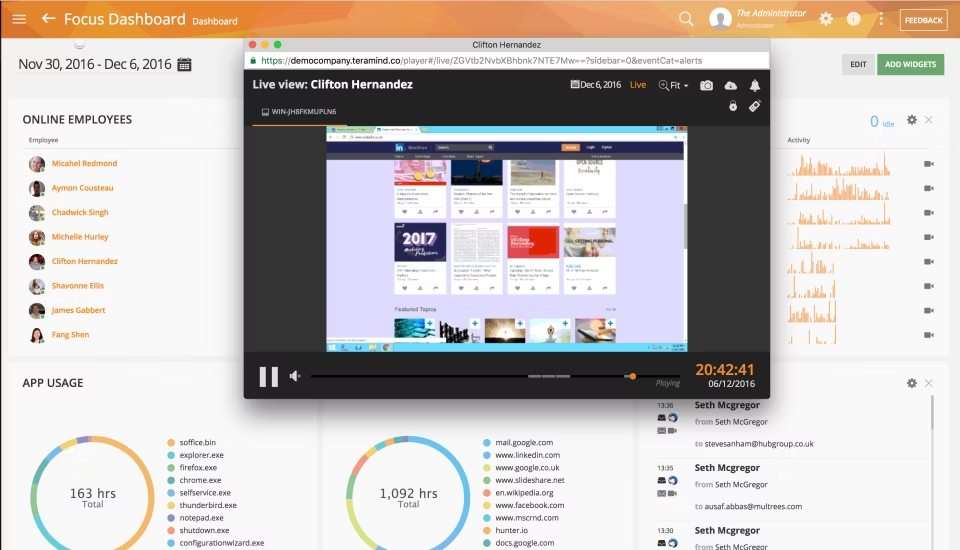Discover crucial HR skills for leaders in today’s changing workforce landscape.
The professional workforce has experienced significant change over the last few years. Employees are invested in work-life balance, and diversity, equity, and inclusion (DEI) initiatives are an important part of maintaining a positive and open culture. More organizations are also operating remotely, allowing for global teams and online interactions.
Human resource (HR) leaders are often the champions of workplace culture and play a critical role in determining their department’s effectiveness. As new workplace paradigms emerge, HR leaders must adapt and develop new skills that are growing in importance.
In this article, we will discuss empathy, data processing, and workforce planning as three vital skills for HR leaders to have.
Empathy is emerging as a must-have skill for HR managers
Empathy is the ability to understand and share the feelings of another. Empathy is a soft skill and HR leaders can have a powerful impact on their organization when they demonstrate empathy in a variety of scenarios. From employees experiencing family struggles to new parents adapting to young children at home, empathetic HR leaders foster a community of openness and encouragement.
Empathy is also a sign of strong emotional intelligence, which is a must-have skill for HR leaders. HR managers need to be able to emotionally understand what employees are feeling and envision what it would be like in that employee’s shoes. For example, when HR leaders can visualize what life might look like waking up four or five times at night with a newborn, they’re able to appropriately support employees through their problems.
It’s also important to note that empathy and sympathy are not the same thing. Sympathy entails feeling sorrow or pity for the struggles of another person, which is also important for compassionate HR leaders. However, empathy is the ability to share someone else’s feelings, which allows for unique perspectives and alternative points of view.
Empathy is key to fostering inclusivity
A core component of empathy is inclusivity. According to Gartner’s Top 5 Priorities for HR Leaders in 2023, 92% of HR leaders believe their organizations can’t be competitive in the talent market without great leadership and that the definition of an excellent leader is changing.[1] Empathetic leaders who support inclusive, welcoming work environments are vital to hiring and retaining top talent.
Lynanne Kunkel, chief human resources officer at Vail Resorts, explains, “Faced with social and political turbulence, work-life fusion and flexible work arrangements, leaders must navigate not simply a leader-to-employee relationship, but a human-to-human one. They must do so by leading with authenticity, empathy, and adaptivity.”[2]
3 ways you can develop empathy as a skill
Practice active listening
Active listening is the concept of observing verbal and nonverbal language and illustrating attentiveness to what someone is saying. Active listening is an important building block of compassionate leadership, indicating HR leaders are paying attention to what employees are saying and giving feedback while refraining from judgment.
With active listening, HR leaders can visualize an employee’s unique situation and intimately understand why they might be facing a difficult day at work. Instead of focusing on their next response, HR leaders should take a pause to closely listen to how an employee is feeling.
Be transparent in communications
Employees place a high value on companies that are transparent and open when it comes to goals, priorities, leadership changes, and organizational restructuring. At a time when many businesses are conducting layoffs, transparency—in terms of financial projections, sales, revenue, and outcomes—is important in building a safe, inclusive team environment.
When employees feel in the loop about what is happening, they are less likely to search for other jobs or pursue other opportunities. Whether that is monthly business reviews or surveys where employees can leave anonymous feedback, HR leaders should encourage executive teams to be as transparent as possible.
Embrace human leadership
According to Capterra, human leadership revolves around the idea that managers should model what it means to bring one’s full self to work. Through authenticity, empathetic care, and adaptive flexibility, human leadership can increase employee intent to stay, engagement, and overall well-being. Human leadership is the new gold standard for effective managers, and employees expect a certain level of respect and empathy from the executive suite.
The growing significance of data processing as a skill
Data processing takes large amounts of raw data and translates it into actionable, usable information. Data processing combines data from different sources to create visual representations that help drive informed decision-making. As only 23.9% of companies believe they have a data-driven culture, human resource leaders should feel comfortable and confident when taking raw data inputs and turning them into actionable insights.[1]
While large enterprise organizations might have the need for a full-time data scientist role, many SMBs can assign this responsibility to an HR manager. For example, employee engagement surveys are not helpful if data and results aren’t aggregated into ways that can be easily understood and put into action by leadership.
According to Lynanne Kunkel, “At the end of the day, HR is a business function…[leaders] must be both analytical…and empathetic…to find solutions that practically solve the business problem in a way that creates the desired employee experience.”[2]
3 ways to develop data processing as a skill
Automate processes with HR analytics software
HR analytics software automates the tedious aspects of data processing while also turning it into visual representations to accelerate data-driven decision-making. Sophisticated tools can even support compensation plan modeling, leave tracking, and succession planning. Plus, software automation allows for visibility and transparency across the organization, making it easy for other leadership to identify trends and actionable insights.

Focus dashboard view in Teramind (Source)
Start small
HR leaders won’t become data scientists overnight. Start small with one focused area. With a small amount of data, use HR analytics software to automate the bulk of the work. For example, try conducting a skills gap analysis for a specific department or team. As the HR leader, you can step in at that point to create takeaways and action plans based on insights.
Take a data ethics course
As AI usage grows in HR, data ethics becomes more and more important. Data ethics courses examine the ethical and privacy implications of collecting and managing potentially sensitive data. Especially when it comes to information around salaries, engagement, or plans to leave the company, HR leaders are privy to very private facets of employee information. Data ethics courses can help HR leaders navigate potential issues, understand biases, and develop their overall data literacy.
Workforce planning as a skill continues to be essential
Workforce planning is a strategic HR function and a growing must-have for organizations that want to future-proof their operations. Companies are faced with a unique set of economic challenges, including a well-known talent shortage, inflation, rising salaries, and supply chain disruptions. All of these pressures work together to make workforce planning an essential tool for analyzing and forecasting workforce supply and demand.
3 ways to develop workforce planning as a skill
Identify skills gaps
Skills-based workforce planning helps companies attract talent who are better suited to fill gaps. Observe the day-to-day operations of the business to determine any soft or hard skills that current employees are lacking. Common examples include critical thinking, communication, and leadership skills. Build a plan to recruit talent that helps alleviate these gaps.
Create employee development paths
It’s more expensive to hire new employees than simply retain existing ones, so reducing regrettable employee turnover is important. Create an employee development path, so high-performing team members see a trajectory for career advancement, more pay, and personal growth.

Skills tracker view on SkillsDB (Source)
Consider investing in workforce management software
When it comes to predictions and modeling, workforce management software aggregates your company’s data and trends. It helps increase engagement, reduce burnout, and boost employee productivity. The tool provides reports in real time, helping you track patterns and trends.
Develop both hard and soft skills as an HR leader
Great HR leaders are more vital than ever as organizations face intense pressure to future-proof their operations while also fostering inclusive work culture. From increased empathy to hard data processing and strategic workforce planning, HR leaders can continue to improve their business acumen and effectiveness by improving their hard and soft skills. HR leaders can establish themselves as strategic business executives who know how to rely on data-driven decision-making and high-level workforce planning to support leadership.
Brush up on the latest trends in HR with these resources:

